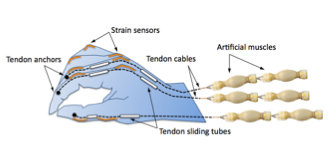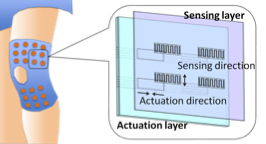
A sequence of motion frames of a normally kicking baby's legs (shown in blue and green), illustrating changing joint angles at the hip and knee.
Countless scientific epiphanies never leave the bench – unless there’s the kind of serendipitous encounter that set Children’s Hospital Boston psychologist Gene Goldfield on a path he never expected to follow.
One in eight babies are born prematurely, putting them at greater risk for cerebral palsy, an inability to fully control their muscles. Goldfield saw these children being wheeled around the hospital, and was convinced that they did not have to be wheelchair-bound.
During early infancy, he knew, the developing brain naturally undergoes a rewiring of its circuits, including those that control the muscles. Could some type of early intervention encourage more typical motor development by replacing damaged circuits with more functional connections?
At Children’s Innovators’ Forum last week, Goldfield discussed his envisioned solution: the use of programmable robots to promote new brain connectivity and improve mobility.
Using robots in rehabilitation is not a new idea. However, existing robots – such as the Lokomat – don’t translate well to children, primarily because they’re designed for a single purpose, such as gait training. Goldfield came up with the idea of a programmable “second skin”: a soft, wearable, multifunctional robot. The robotic clothing would sense the strain when a baby’s muscle is trying to move and recruit synthetic “muscles” to apply an assistive force, reinforcing motor circuits in the developing brain.
The serendipitous encounter occurred in a coffee shop, where Goldfield bumped into Don Ingber from the Wyss Institute for Biologically-Inspired Engineering. Although Goldfield already had seed funding, the chance meeting led to a collaboration that dramatically altered the course of the project.

Strain sensors detect when a muscle is trying to move; artificial muscles provide an assistive force that reinforces motor circuits in the brain.
Research on the second skin now involves Children’s behavioral scientists, neurologists and cerebral palsy teams; the Wyss Institute’s engineers and staff; Beth Israel Deaconess Medical Center neonatologists; and collaborators from Harvard, Boston University, MIT and Draper Laboratory. The project has also received funding from the National Science Foundation and the NIH.
Mary Tolikas, director of operations at the Wyss Institute, also spoke at last week’s forum, sponsored by Children’s Innovation Acceleration Program. Funded from the single largest gift in Harvard’s history of $125 million, the Wyss focuses on high-risk research and technology development with the goal of putting products in the pipeline.
The Wyss is structured to harness the considerable talent in the Boston/Cambridge area by forming alliances among Children’s Hospital Boston, Harvard University, Dana-Farber Cancer Institute, Boston University, Brigham and Women’s Hospital, UMass Medical School, Massachusetts General Hospital, Beth Israel Deaconess Medical Center and Spaulding Rehabilitation Hospital. (Under such alliances, Children’s and Wyss have also co-developed the lung-on-a-chip, designed to replace animal testing and accelerate drug development, and a magnetic/microfluidic system designed to remove pathogens from the blood in patients with sepsis.)
Tolikas pointed out that the Wyss Institute has already worked out revenue-sharing and confidentiality agreements with its nine partner institutions, relieving innovators’ concerns about intellectual property and non-disclosure agreements. By minimizing legal and resource burdens, innovators can collaborate more openly and across disciplines.
With Wyss support, Goldfield and a team of more than a dozen researchers are now studying how the second-skin software can be reconfigured for different functions, since there do not seem to be other wearable robots that are multifunctional. While he’s careful not to overpromise, his dream for the next generation of his project is to develop a prototype for a whole limb to prevent debilitating effects of injury.
By his own account, Goldfield might have stumbled on his own for a long time had he not had the serendipitous encounter with Ingber and the subsequent support from the Wyss Institute. He emphasizes the importance of remaining ahead of the curve: “You must always be thinking about the next generation of your innovation,” he said.
 Sarah Mahoney is a member of Children’s Hospital Boston’s Innovation Acceleration Program team as Community Manager of Children’s internal collaboration and social networking site.
Sarah Mahoney is a member of Children’s Hospital Boston’s Innovation Acceleration Program team as Community Manager of Children’s internal collaboration and social networking site.








